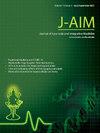结合宏观显微镜、DNA条形码和HPTLC技术对以Maramanjal/Daruharidra交易的含有小檗碱的植物药进行质量评价
IF 1.9
Q3 INTEGRATIVE & COMPLEMENTARY MEDICINE
引用次数: 0
摘要
daruharidra /Maramanjal是阿育吠陀、悉达和其他印度医疗系统中最受欢迎的灌木之一。以这个名字进行交易的植物来源不止一种,主要是小檗(Berberis aristata)和黄连木(coscium fenestratum),年交易量为1000-2000公吨。由于形态相似和白话名称混淆,草药贸易经常报告有误认、掺假和/或替代问题。本研究旨在整合宏观显微镜、DNA标记策略和植物化学分析方法来区分马兜铃小檗及其贸易来源。材料和方法从印度市场的不同地区以商品名Maramanjal/Daruharidra收集了13个市场样本和一个来自自然栖息地的真实实地样本。传统的鉴定方法包括宏观显微镜和高效薄层色谱(HPTLC)筛选。此外,利用ITS2 (Internal transcripsed Spacer 2)标记进行了基于DNA条形码的分子鉴定和系统发育分析。结果宏观观察结果显示,除了印度北部的马兜铃和印度南部的凤尾草等公认的植物来源外,还有80%的植物混合在一起。DNA条形码能够从收集的样品中识别真假原料药。hplc定量分析显示,14份样品中小檗碱的含量在1.12% ~ 26.33%之间。结论宏微观、HPTLC和DNA条形码技术有助于鉴别该药材的掺假和替代行为。DNA条形码可以证明是一种有效的工具,用于发现掺假和替代的Maramanjal/Daruharidra,这是其首次应用形态学,显微镜,植物化学分析和DNA标记来区分这些交易物种。本文章由计算机程序翻译,如有差异,请以英文原文为准。
Integrating macro-microscopy, DNA barcoding and HPTLC for quality assessment of berberine containing botanicals traded as Maramanjal/Daruharidra
Background
Daruharidra/Maramanjal is one of the most popular shrub used in Ayurveda, Siddha and other Indian medicinal systems. More than one botanical source is traded under this name, predominantly Berberis aristata and Coscinium fenestratum with an annual trade of 1000–2000 metric tonnes. The herbal drug trade is often reported with misidentification, adulteration and/or substitution issues due to morphological resemblance and confusion in vernacular names. This work aimed to integrate macro-microscopic, DNA marker strategies and phytochemical assay to differentiate Berberis aristata from its traded sources.
Material and methods
Thirteen marketed samples and one authentic field sample from natural habitat were collected from various regions of the Indian market under the trade name Maramanjal/Daruharidra. The traditional identification methods included macro-microscopic and phytochemical screening by High-Performance Thin Layer Chromatography (HPTLC). Additionally, DNA barcode-based molecular identification and phylogenetic analysis were done using the ITS2 (Internal Transcribed Spacer 2) marker.
Results
The macroscopic observations revealed 80 % ad-mixing of various allied botanicals in addition to accepted north Indian and south Indian sources such as B. aristata and C. fenestratum respectively. DNA barcoding enabled the identification of genuine and adulterated raw drugs from the collected samples. The HPTLC quantification revealed the presence of berberine in all 14 samples varying from 1.12 % to 26.33 %.
Conclusions
The macro-micro, HPTLC, and DNA barcoding helped in the identification of adulteration and substitution practices in this highly traded botanical drug. DNA barcoding can prove an effective tool for discovering the adulteration and substitution of Maramanjal/Daruharidra and this is its first report on the application of morphology, microscopy, phytochemical analysis, and DNA markers in differentiating these traded species.
求助全文
通过发布文献求助,成功后即可免费获取论文全文。
去求助
来源期刊

Journal of Ayurveda and Integrative Medicine
INTEGRATIVE & COMPLEMENTARY MEDICINE-
CiteScore
4.70
自引率
12.50%
发文量
136
审稿时长
30 weeks
 求助内容:
求助内容: 应助结果提醒方式:
应助结果提醒方式:


